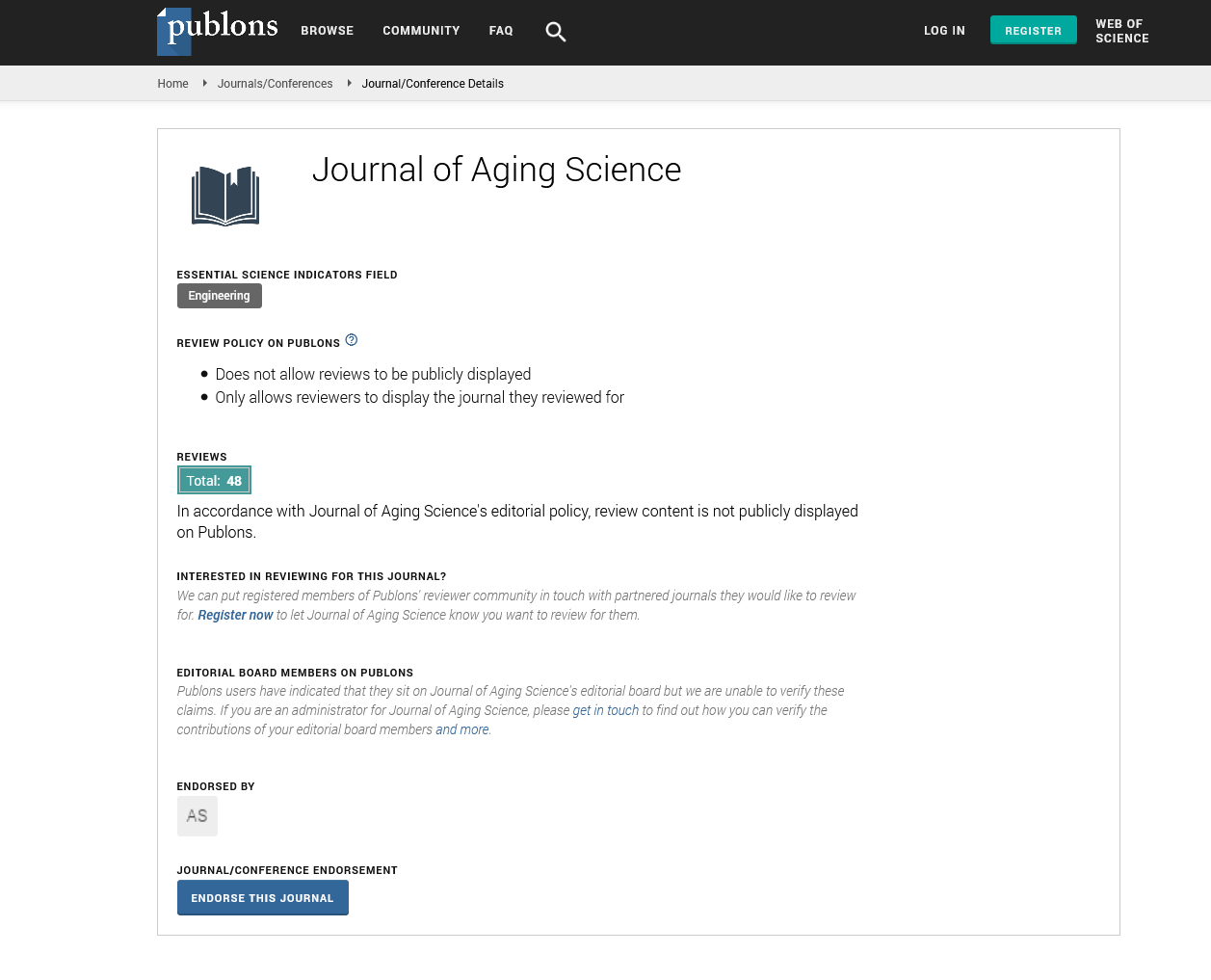Indexed In
- Open J Gate
- Academic Keys
- JournalTOCs
- ResearchBible
- RefSeek
- Hamdard University
- EBSCO A-Z
- OCLC- WorldCat
- Publons
- Geneva Foundation for Medical Education and Research
- Euro Pub
- Google Scholar
Useful Links
Share This Page
Journal Flyer

Open Access Journals
- Agri and Aquaculture
- Biochemistry
- Bioinformatics & Systems Biology
- Business & Management
- Chemistry
- Clinical Sciences
- Engineering
- Food & Nutrition
- General Science
- Genetics & Molecular Biology
- Immunology & Microbiology
- Medical Sciences
- Neuroscience & Psychology
- Nursing & Health Care
- Pharmaceutical Sciences
Perspective - (2025) Volume 13, Issue 1
Mitochondrial Dysfunction and Aging-Related Diseases
David Paul*Received: 27-Feb-2025, Manuscript No. JASC-25-28486; Editor assigned: 01-Mar-2025, Pre QC No. JASC-25-28486 (PQ); Reviewed: 07-Mar-2025, QC No. JASC-25-28486; Revised: 14-Mar-2025, Manuscript No. JASC-25-28486 (R); Published: 28-Mar-2025, DOI: 10.35248/2329-8847.25.13.398
Description
Mitochondria, often referred to as the powerhouses of the cell, play a pivotal role in cellular energy production through oxidative phosphorylation. They also regulate Reactive Oxygen Species (ROS) homeostasis, apoptosis and various metabolic pathways. However, mitochondrial function deteriorates with age, leading to mitochondrial dysfunction, which is strongly implicated in numerous aging-related diseases, including neurodegenerative disorders, cardiovascular diseases, metabolic syndromes and cancer. This article explores the mechanisms underlying mitochondrial dysfunction in aging and its contributions to age-related diseases.
Mitochondrial dysfunction in aging
Aging is characterized by a gradual decline in cellular function and an increased susceptibility to diseases. Mitochondrial dysfunction plays a central role in the aging process due to several key mechanisms:
Mitochondrial DNA (mtDNA) mutations: Unlike nuclear DNA, mtDNA lacks strong repair mechanisms, making it more susceptible to oxidative damage and mutations over time. Accumulation of mtDNA mutations leads to defective Electron Transport Chain (ETC) function and impaired ATP production.
Oxidative stress and ros accumulation: Mitochondria are the primary source of ROS, which are byproducts of aerobic respiration. Although low levels of ROS act as signaling molecules, excessive ROS production results in oxidative damage to proteins, lipids and DNA, increasing mitochondrial dysfunction.
Decreased mitochondrial biogenesis: Aging is associated with reduced expression of peroxisome Proliferator-Activated Receptor Gamma Coactivator-1 alpha (PGC-1α), a key regulator of mitochondrial biogenesis. This leads to diminished mitochondrial content and function in aging cells.
Mitochondrial dysfunction and aging-related diseases
Neurodegenerative diseases: Mitochondrial dysfunction is strongly implicated in neurodegenerative diseases such as Alzheimer’s Disease (AD), Parkinson’s Disease (PD) and Amyotrophic Lateral Sclerosis (ALS). Neurons rely heavily on mitochondrial energy production and mitochondrial failure leads to neuronal death and cognitive decline.
• Alzheimer’s Disease (AD): Mitochondrial dysfunction contributes to Amyloid-beta (Aβ) toxicity and tau pathology. Defective mitochondria fail to supply adequate ATP to neurons, leading to synaptic dysfunction and neurodegeneration.
• Parkinson’s Disease (PD): Mutations in genes such as PINK1 and Parkin, which regulate mitophagy, result in the accumulation of dysfunctional mitochondria and increased oxidative stress in dopaminergic neurons, leading to motor dysfunction.
Cardiovascular diseases: Cardiomyocytes are highly energydependent, making them particularly vulnerable to mitochondrial dysfunction. Impaired mitochondrial function in the heart is associated with heart failure, ischemia-reperfusion injury and atherosclerosis.
• Heart failure: Mitochondrial defects in ATP production lead to energy-starved cardiomyocytes, contributing to contractile dysfunction and heart failure.
• Atherosclerosis: Mitochondrial ROS promote inflammation and oxidative modification of Low-Density Lipoproteins (LDL), accelerating the formation of atherosclerotic plaques. Metabolic disorders: Mitochondrial dysfunction plays a significant role in metabolic diseases, including type 2 diabetes and obesity.
• Type 2 Diabetes (T2D): Mitochondrial defects in insulinsensitive tissues, such as skeletal muscle and adipose tissue, lead to insulin resistance and impaired glucose metabolism.
• Obesity: Impaired mitochondrial function in adipocytes disrupts energy balance and lipid metabolism, contributing to obesity-related complications.
Cancer: Mitochondria are important in regulating cell metabolism and apoptosis. Mitochondrial dysfunction in cancer cells promotes metabolic reprogramming, allowing uncontrolled cell proliferation.
• Warburg effect: Many cancer cells rely on glycolysis instead of oxidative phosphorylation for energy production, even in oxygen-rich environments. This metabolic shift is associated with mitochondrial dysfunction and enhanced survival of cancer cells.
Therapeutic strategies targeting mitochondrial dysfunction
Given the central role of mitochondrial dysfunction in agingrelated diseases, several therapeutic approaches have been explored:
Mitochondrial antioxidants: Targeted antioxidants, such as MitoQ and SkQ1, aim to reduce mitochondrial oxidative stress and protect against age-related damage.
Nutritional and pharmacological interventions: Caloric restriction, exercise and pharmacological agents like resveratrol and metformin activate PGC-1α, enhancing mitochondrial biogenesis and function.
Conclusion
Mitochondrial dysfunction is a hallmark of aging and a driving force behind numerous age-related diseases. Understanding the mechanisms that underlie mitochondrial decline provides valuable insights into disease pathogenesis and potential therapeutic targets. By enhancing mitochondrial function through lifestyle modifications, pharmacological interventions and emerging gene therapies, it may be possible to mitigate aging-related diseases and improve healthspan.
Citation: Paul D (2025). Mitochondrial Dysfunction and Aging-Related Diseases. J Aging Sci. 13:398.
Copyright: © 2025 Paul D. This is an open-access article distributed under the terms of the Creative Commons Attribution License, which permits unrestricted use, distribution and reproduction in any medium, provided the original author and source are credited.

